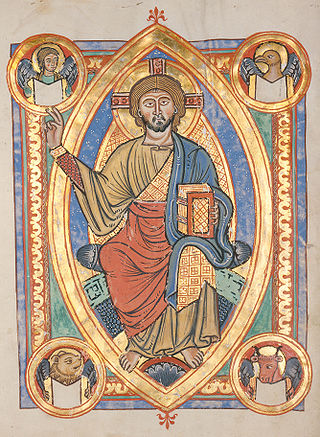In a number of Christian traditions, including Orthodoxy, Catholicism, Lutheranism, and Anglicanism, a confessor is a priest who hears the confessions of penitents and pronounces absolution.

Eucharistic adoration is a Eucharistic devotional practice primarily in Western Catholicism, but also to a lesser extent in certain Lutheran and Anglican traditions, in which the Blessed Sacrament is adored by the faithful. This practice may occur either when the Eucharist is exposed, or when it is not publicly viewable because it is reserved in a place such as a church tabernacle.

The Franciscan Crown is a rosary consisting of seven decades in commemoration of the Seven Joys of the Virgin, namely, the Annunciation, the Visitation, the Nativity of Jesus, the Adoration of the Magi, the Finding in the Temple, the Resurrection of Jesus, and finally, either or both the Assumption of Mary and the Coronation of the Virgin. Devotion to the seven joys of Mary is found in a variety of forms and communities. It is especially popular with the Franciscans, Cistercians, and the Annunciades of St. Joan of France. The devotion was granted many indulgences by different popes, becoming the most heavily indulgenced devotion in the Catholic Church. In order for any associated indulgences to be received it was not necessary for a Franciscan rosary to have been blessed or even to use beads at all.

Agnes of Montepulciano was a Dominican prioress in medieval Tuscany, who was known as a miracle worker during her lifetime. She is honored as a saint by the Catholic Church.
The Third Order of Saint Francis is a third order in the Franciscan tradition of Christianity, founded by the medieval Italian Catholic friar Francis of Assisi.

Catholic devotions are particular customs, rituals, and practices of worship of God or honour of the saints which are in addition to the liturgy of the Catholic Church. The United States Conference of Catholic Bishops describes devotions as "expressions of love and fidelity that arise from the intersection of one's own faith, culture and the Gospel of Jesus Christ". Devotions are not considered part of liturgical worship, even if they are performed in a church or led by a priest, but rather they are paraliturgical. The Congregation for Divine Worship at the Vatican publishes a Directory on Popular Piety and the Liturgy.
Peter de Honestis was born at Ravenna. Among his distant relatives was St. Romuald, founder of the Camaldolese monks. All his life Peter fasted on Saturday in honour of Our Lady, and strongly recommended this practice to his religious.
Forty Hours' Devotion, in Italian called Quarant'ore or written in one word Quarantore, is a Roman Catholic liturgical action in which continuous prayer is made for forty hours before the Blessed Sacrament in solemn exposition. It often occurs in a succession of churches, with one finishing prayers at the same time as the next takes it up.

The Sisters of the Blessed Sacrament (SBS) are a Catholic order of religious sisters in the United States. They were founded in 1891 by Katharine Drexel as the Sisters of the Blessed Sacrament for Indians and People of Color.

The Third Order of Saint Dominic, also referred to as the Lay Fraternities of Saint Dominic or Lay Dominicans since 1972, is a Catholic third order which is part of the Dominican Order.
The Tabernacle Societies were lay Eucharistic Adorative associations within Roman Catholic parishes, principally in America and Australia, forming part of the Archassociation of the Eucharist under the guidance of the Association of Perpetual Adoration of the Blessed Sacrament.
Servants of the Most Blessed Sacrament is a Roman Catholic religious institute of women, founded by the Pierre-Julien Eymard in 1858, assisted by Marguerite Guillot, with the authorization of François-Nicholas-Madeleine Morlot, the Archbishop of Paris.
The Sisters of the Blessed Sacrament and Our Lady is an enclosed religious order and a reform of the Dominican Order devoted to the perpetual adoration of the Blessed Sacrament. The congregation was founded in Marseille in 1659 by a Dominican priest, Anthony Le Quieu.
Religious of Perpetual Adoration is a Roman Catholic religious order formed in 1857 by Anna de Meeus, in Brussels, Belgium.

Blessed Gertrude of Aldenberg, was a German noblewoman and abbess. She was the daughter of Elizabeth of Hungary and of Louis IV, Landgrave of Thuringia. She became a Premonstratensian canoness regular at the Abbey of Aldenberg, near Wetzlar, in the Diocese of Trier, where she spent much of her life leading the community as its abbess. She was beatified in 1728, her feast is August 13.

The Roman Catholic tradition includes a number of devotions to Jesus Christ. Like all Catholic devotions, these prayer forms are not part of the official public liturgy of the Church but are based on the popular spiritual practices of Roman Catholics. Many are officially approved by the Holy See as suitable for spiritual growth but not necessary for salvation.

Mechtilde of the Blessed Sacrament, born Catherine de Bar was a French nun, the founder of the order of Benedictine Nuns of Perpetual Adoration of the Blessed Sacrament. She is recognized as the Servant of God in the Catholic Church.
The Sisters of the Precious Blood is a Roman Catholic female religious order founded in 1845 in Steinerberg, Switzerland by Magdalene Weber and a number of young women from Baden.
The Order of the Blessed Sacrament is an enclosed congregation and a reform of the Dominican Order devoted to the perpetual adoration of the Blessed Sacrament.

A religious sister in the Catholic Church is a woman who has taken public vows in a religious institute dedicated to apostolic works, as distinguished from a nun who lives a cloistered monastic life dedicated to prayer. Both nuns and sisters use the term "sister" as a form of address.










